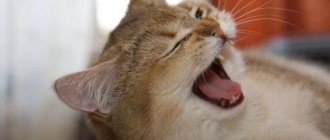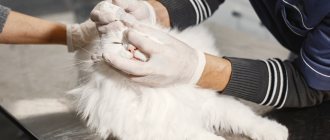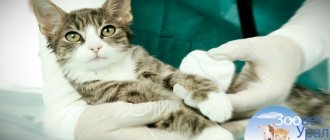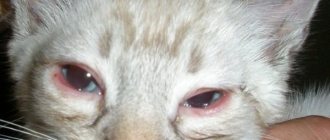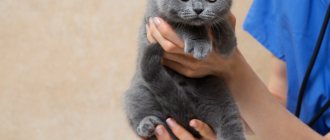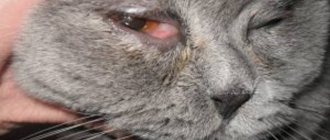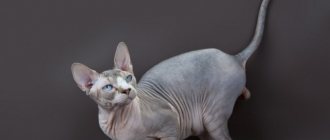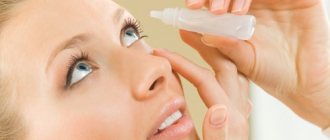13242Administration
1
Many owners often wonder why their cat sneezes and his eyes water. Some consult with a veterinarian, others try to overcome it on their own by washing the eyeball with herbal or tea infusions, while others hope that it will go away on its own.
Often the owner still pays attention to the fact that the animal is sneezing. If it sneezes due to dust particles getting into the nasal passage, then there is no need to worry. But when a runny nose and sneezing become permanent, it is necessary to figure out why the animal is sneezing and eliminate the disease.
Tears in animals perform a protective function, which is similar to the processes occurring in humans. Tears appear if dust or speck gets in. This is normal. But if the cat behaves restlessly and the flow of tears continues for a sufficient time, then this process must be stopped.
© shutterstock
If a cat’s eyes are watery and sneezing at the same time, then these are good reasons to seek help from a doctor.
Why does a cat sneeze and her eyes water?
In fact, there can be many reasons for this condition of a pet: from the simplest to quite serious. Below we will look at some of the most common ones:
- Common mucosal irritation. It can be caused by dust or tobacco smoke, for example. In this case, there is no need to worry - you need to get rid of the possible irritant.
- Allergy. Cats, like humans, can have allergies to pollen, perfumes and plants. It may be accompanied not only by sneezing and watery eyes, but also by vomiting, shortness of breath and a rash.
- Cold. In this case, your pet will have a fever, lethargy and cough. A veterinarian's consultation is necessary for an accurate diagnosis.
- Injury. If something gets into your nose or eye, you may experience watery eyes and sneezing. The solution is to remove the possible irritant and treat the eye and nose with saline solution or plain water.
- Asthma will be accompanied by wheezing and increased coughing. And sneezing and tears will be a consequence of this condition.
- Parasites can also cause tears and sneezing. And if you haven’t treated your cat and she has, among other things, vomiting and diarrhea, you need to get tested for helminths.
- Conjunctivitis. In this condition, the cat's eyes suffer more - pus and redness appear. A veterinarian can prescribe the correct treatment.
With the help of drugs
When an animal sneezes and its pupils are watery, the doctor suggests treatment with the following means:
- Anandin. This medicine helps in rapid healing of wounds and has antimicrobial effects;
- Maxidin. Has good immunostimulating properties. May help with inflammation of the eyes and rhinitis;
- Thymogen. This is a drug that regulates the immune system.
If no positive trends are observed, then, on the recommendation of a doctor and under his supervision, the following pills should be taken:
- Naphthyzin. It comes in the form of nasal or eye drops. Has the property of constricting blood vessels and has an antiphlogistic effect;
- Dioxidine. It is used for purulent rhinitis and has disinfectant properties;
- Derinat. Helps strengthen the immune system, used mainly for rhinitis and conjunctivitis;
- Nazivin. It comes in the form of drops: both for the nose and for the eyes. Used to reduce inflammation in these areas.
© shutterstock
If the cat has a serious illness, then the following medications are prescribed:
- Drops "Diamond eyes". They have an antimicrobial and regenerating effect thanks to components such as chlorhexidine, sodium succinate and taurine;
- Furacilin. It is contained in the drug "Bars", which fights microbes well. Novocaine, which is part of it, anesthetizes. Prescribed for severe keratitis;
- “Iris” is the name given to the drops that are used to treat a corneal ulcer. The composition contains the antibiotic gentamicin and many healing elements;
- To treat inflammation of the conjunctiva, Ciprovet is used, which contains the antibiotic ciprofloxacin.
Could these be symptoms of dangerous diseases?
If a kitten or adult cat's eyes are watery and he/she is sneezing, a serious medical condition may be present. Only a veterinarian can diagnose it, so if you notice additional symptoms, you should immediately consult a doctor.
Dangerous accompanying symptoms:
- The cat vomits frequently and has diarrhea.
- The color of the eyes changed and became darker.
- Sudden weight gain or loss.
- Fever and high temperature.
- Lethargy, apathy.
- Blood in the discharge from the nose or eyes.
- Severe swelling of the mucous membranes.
- Cough and difficulty breathing.
- Skin rashes and ulcers.
The presence of these symptoms may be a sign of feline immunodeficiency virus, rhinotracheitis, calicivirus, infectious diseases and other diseases dangerous to pets.
Important: if you pick up a pet and it exhibits similar symptoms, do not rush to take it home to other animals, they may become infected with one of the infectious diseases.
When is help needed?
If your animal has the following symptoms, then a trip to the veterinarian is required:
- the cat is constantly sneezing;
- his eyes are watering;
- no appetite;
- irritation and itching in the area of the visual organ;
- purulent discharge;
- the eyes became a different color and became cloudy;
- the animal is very lethargic or, on the contrary, overexcited;
- There are deep wounds and cuts.
The doctor will conduct an examination and prescribe the right treatment, thanks to which you will not hear or see your baby sneezing or his eyeballs watering.
How to put drops in a cat's eyes and nose?
Cats are wayward animals and may simply refuse to carry out any procedures, and during illness it may be more difficult for them to bear such stress.
Below are a few steps to complete the procedures without much hassle.
Drops in the eyes
- It is better to perform the procedure together, so that one drips and the other holds.
- Secure your pet's head with a towel.
- Clean any discharge from your eyes using a damp cotton pad.
- Pull back your eyelid and apply.
- Do not let go of your pet for several minutes so that the drug is absorbed.
Nasal drops
- Fix the muzzle vertically. Your left thumb should rest on the chin, and your index finger should rest on your pet's forehead.
- With your right hand, take the medicine and inject or drop it.
Carry out the manipulations calmly, your behavior will affect the pet. Afterwards, be sure to praise your pet and give him a treat.
Treatment at home
In most cases, when a tailed pet does not have accompanying symptoms other than sneezing, it is very simple to help him; for this purpose, rinse the nose with saline .
A 0.9% aqueous solution of sodium chloride can be purchased at any pharmacy - both human and veterinary. In addition to saline solution, you need a 3-5 ml syringe, cotton pads or gauze pads. It is also advisable to prepare two towels: one to lay at the site of the procedure, and the second to wrap the cat in it for fixation (otherwise, without a fight, it is unlikely to allow any manipulations to be carried out).
Before the procedure, the pet should be petted and calmed. If the outside of the nose is contaminated with mucus, dirt, and crusts, this is a signal that it is better to go to the clinic. If the outside of the spout is clean, you can start rinsing. To do this, draw the saline solution into a syringe, warm it in your hands to a comfortable temperature, and be sure to remove the needle from it. Then we fix the pet’s head in a horizontal position; it can be tilted slightly to one side, but there is no need to tilt it up. Insert the tip of the syringe into the nostril shallowly, making a fairly tight fit. By smoothly pressing the piston, introduce 1-1.5 ml of solution. Sudden movements can frighten your pet and cause harm.
After administration, you should give time for the cat to sneeze, after which all excess should be wiped off with a napkin. We do the same with the second nostril. It is recommended to repeat the procedure 2-3 times, usually it is carried out 3 times a day or as prescribed by a doctor. After washing, you need to praise your pet and treat it with treats.
The use of other solutions, drops, tablets without a doctor’s prescription is under no circumstances recommended - you can harm your pet!
Only a doctor can select the right medications and prescribe the dosage, be it antihistamines, antibiotics or anti-inflammatory drugs.
If you find and eliminate an irritant that could cause sneezing, wash your nose, but the situation does not improve, you should immediately seek help from a clinic to diagnose a possible disease.
How to alleviate the course of the disease?
- Make sure that the cat feels safe: there should be no loud noises, drafts, excessive heat and low or high humidity. The cat should be able to go to a secluded place.
- The cat must drink. If this does not happen, the owner must feed the pet with a syringe or pipette.
- The cat must eat.
- Do not deviate from the chosen course of treatment and be sure to complete it.
- Be patient, calm and give your cat more attention and affection.
Treating a cat for sneezing
Only a veterinary specialist at the clinic can prescribe the correct treatment for a cat with symptoms of sneezing. If, during a clinical examination of your cat, a veterinarian determines that your cat is clinically healthy, he will recommend that you wet clean your apartment and use a special humidifier.
If the cause of sneezing is allergic in nature, then recommendations will be given to eliminate the allergen present in the apartment or to ensure that household chemicals are inaccessible to your cat. In order to alleviate the condition, a veterinarian will prescribe one or another antihistamine to your animal.
In the case where the cause of sneezing is polyps, it will be recommended to remove them surgically in a veterinary clinic.
If a cat's sneezing is accompanied by an asthmatic attack, antispasmodics, vasoconstrictors and corticosteroids are prescribed.
In case of diseases of the oral cavity (teeth, gums), a sick cat is given dental treatment, tartar is removed (tartar in cats), inflammation of the gums is relieved, and vitamins are prescribed.
If a helminthic infestation is detected in a cat during an examination, the veterinarian will prescribe special anthelmintic drugs.
If the cause of a cat’s sneezing is an infectious disease diagnosed in the clinic’s laboratory, then the sick animal will be prescribed antibacterial and antiviral drugs and immunomodulators.
The oncological cause of sneezing in a cat is eliminated by performing surgery to remove the tumor and prescribing a course of chemotherapy.
How to prevent such a situation?
Treating is always more difficult than preventing a disease. Because in reality, not much is required from the owner:
- treat your pet carefully and monitor for possible changes in behavior and appearance;
- carry out regular vaccinations;
- keep your cat's toys and litter box clean;
- rinse eyes and clean if lumps form;
- carry out deworming once every three months;
- feed correctly and prevent “table food”;
- provide access to clean and fresh water;
- Visit the veterinarian at least once a year and promptly contact the veterinarian for any changes.
Prevention
If the cat’s sneezing is harmless and caused by the presence of dust in the apartment, then the owners will need to keep their apartment clean and regularly carry out wet cleaning of the room. If sneezing is allergic, owners must protect their pet from the allergen (air freshener, perfume, perfume, washing powder, tobacco smoke, etc.).
An effective way to prevent the infectious component of cat sneezing is to vaccinate animals according to the existing schedule. Starting from six months, you need to follow the vaccination schedule and vaccinate them against: viruses; cat flu; leukemia and leukopenia; rabies.
Oral diseases are prevented by constant monitoring of the condition of the oral cavity and teeth, and timely removal of tartar.
Worm infestations in cats are prevented by regular deworming of the animal with anthelmintics.
The main thing is to undergo regular preventive examinations of your cat at a veterinary clinic in order to detect danger in time and begin timely treatment.
Features of symptoms
Sneezing is not the only symptom indicating that your pet is unwell. Depending on the cause and degree of neglect of the disease, the following clinical manifestations develop:
- eyes are swollen, lacrimation is small, moderate;
- the hair around the eyes falls out, eczema and dermatitis develop;
- the consistency of the discharge changes;
- the animal rubs its head on various objects due to itching;
- dry discharge in the corners of the eyes;
- redness, swelling of the conjunctiva;
- fear of light.
If your pet is constantly sneezing and the tearing does not go away, you need the help of a veterinarian. The doctor will tell you what to do to eliminate the symptoms after an accurate diagnosis is made.
How does a cold manifest in cats?
Colds in cats. The symptoms of viral diseases in cats are similar, however, successful treatment is only possible with the correct diagnosis. Therefore, when your pet shows signs of a cold, you should urgently consult a specialist. Tests may be needed to determine the virus that causes the illness. Colds are more common in kittens due to their rather weak immunity. The main symptoms include:
- increased body temperature (nose becomes dry and hot)
- lack of appetite
- runny nose and sneezing
- heavy breathing, cough
- tearfulness
- apathy, etc.
The cat has a cold and is sneezing: what to do?
If your pet is sneezing, coughing, the nose is dry and hot, the eyes are watery, there is no appetite, breathing is difficult, you should give the cat first aid.
Algorithm of actions:
- Carry out a visual inspection, analyze whether the disease is the result of a viral infection.
- Place the sick person in a comfortable, warm place, making sure there are no drafts.
- Put a heating pad on if the animal is cold.
- Give plenty of warm water and milk. Cold drinks are prohibited.
- Massage your body to increase blood circulation.
- Offer nutritious food.
If after two or three days the pet’s condition remains unchanged, you must visit a veterinary clinic, where the doctor will make an accurate diagnosis.
Cat flu: symptoms
Cat flu, the symptoms and treatment of which raise many questions, has an incubation period of 2-10 days. The virus can be transmitted from a sick animal, for example, in a nursery, or from a carrier through airborne droplets. The principle of virus penetration into the body is the same as in humans - through the mucous membranes of the oral cavity and through the conjunctiva of the eyes. The contact variant is less common - through products, sleeping accessories, cups, etc.
Article on the topic Medical battalion at home. How to organize treatment for a pet
A clear sign of cat flu is a runny nose. Also among the symptoms indicating pathology are:
- sneezing;
- conjunctivitis;
- increased body temperature;
- febrile conditions.
Also, a sick cat will be tired and weak; it will eat less or refuse to eat at all. If the cat's flu is caused by a calcivirus, it is milder. The situation becomes much more complicated if a bacterial infection is added. Then the cat may develop:
- pneumonia;
- bronchitis;
- chronic rhinitis.
This situation may occur if there is an outbreak in the cat population.
The hamster has infected! What diseases are transmitted from animals to people? More details
Common Causes
A symptom in which the eyes cut and water can occur for the following reasons:
- Long-term eye strain , which occurs when constantly working at a computer or reading for a long time.
- Staying for a long time in dry air conditions (for example, in a room with air conditioning).
- Insufficient lighting or lack of natural light in the room.
- Diseases of inflammatory or infectious origin.
- Injuries and damage to the organs of vision , including foreign bodies entering the eyes and thermal or chemical burns.
- Allergic reactions upon contact with various allergens (in such cases, the symptom may occur at certain times of the year or when certain irritants come into contact with the eyes).
Keep in mind! The eyes often sting and watery eyes in people who wear contact lenses.
In such cases, the cause may be either increased sensitivity of the mucous membrane and cornea to such optics, or improper use of lenses (wearing expired optics, incorrectly selected lenses, using lenses for longer than the specified time and at night).
When to see a doctor
A sick animal should definitely be seen by a veterinarian if, in addition to sneezing, the following are present:
- tearfulness, purulent discharge from the eyes;
- lack of air;
- coughing;
- pus, ichor from the nose;
- loss of appetite;
- restless rubbing of the nose with a paw, as if something is disturbing;
- wheezing;
- chills;
- hyperthermia;
- dry crusts near the nostrils;
- diarrhea;
It is difficult to figure out on your own the reason why your pet often sneezes. It is better to entrust your pet to a doctor, he will make an accurate diagnosis and prescribe adequate treatment.
How to help a sick animal at home
It is impossible to treat a cat without knowing the cause of the pathology. Need specialist advice.
Conditions favorable for the sick animal are created at home:
- contact with potential allergens is excluded;
- drafts and other negative factors are eliminated;
- Wet cleaning is carried out in the room;
- pet care rules are followed.
The best solution is to immediately consult a doctor. But there are situations when there is no veterinarian nearby.
Remedies that can help in this case:
- Furacilin (used for washing the organs of vision for conjunctivitis);
- an aqueous solution of Levomycetin (helps eliminate bacterial conjunctivitis, the product is instilled into both eyes);
- antibiotic-based ointments;
- solution of Novocaine, Hydrocortisone (eliminates pain, used as injections);
- Hormonal drugs are indicated in case of the development of a severe allergic reaction.
Drug therapy
Therapy is aimed at eliminating the causes of the painful condition. The following groups of drugs are prescribed:
- antibiotics;
- antiallergic drugs;
- antiviral drugs.
Measures are being taken to strengthen the immune system.
The following drugs are prescribed:
- Anandin . It has a wound-healing, antiphlogistic effect, relieving inflammation.
- Maxidin . Characterized by an immunostimulating effect. Helps activate the body's protective functions.
- Thymogen . It has an immunomodulatory effect similar to Maxidin.
If these drugs are ineffective, then resort to the use of strong drugs, including:
- Naphthyzin. Has an anti-inflammatory, vasoconstrictor effect.
- Dioxidine. The drug has an antiseptic effect and is used for the development of purulent rhinitis.
- Derinat. Immunomodulatory agent that activates defenses. Helps cope with conjunctivitis and rhinitis.
- Nazivin. Has a vasoconstrictor effect. It is used to identify inflammatory processes in the respiratory and vision organs.
- Galazolin. Used to treat otitis and rhinitis.
Severe forms of pathologies are treated with the following medications:
- Diamond eyes;
- Furacilin;
- Iris;
- Tsiprovet;
- preparations based on Levomycetin.
Application of traditional medicine methods
Folk remedies are not used as the main treatment. Decoctions and infusions are used in combination with drug treatment.
The following will help relieve symptoms:
- Chamomile decoction. This is a universal remedy used for washing the organs of vision. The procedure is performed up to 3 times a day.
- Potassium permanganate solution (potassium permanganate). Used to wash eyes. It is necessary to ensure that the crystals are completely dissolved in water, otherwise the animal will receive a burn to the mucous membrane. The solution should be of low concentration and have a pale pink tint.
- Decoctions of sage, St. John's wort, calendula. Used at the beginning of the purulent process.
- Black tea without additives. They are used to wash the eyes during inflammation.
